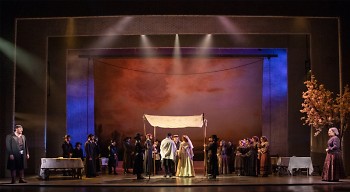Prior to its 1964 debut, even some of its investors fretted that Fiddler On The Roof was "too Jewish." Based on stories written in Yiddish by Sholem Aleichem and set around the turn of the twentieth century, the musical wrestles, however lightly, with tradition, duty, and faith: an unlikely series of ingredients for a hit musical, right? Of course right. But it is one of the most popular musicals of all time.
On Tuesday, October 8th, Broadway Grand Rapids brought the touring show to Devos Performance Hall. The production, largely successful, reminded audience members why the musical has been so embraced: in its particulars, it speaks to universal truths, and besides, the songs are catchy.
After the appropriately brief prologue, villagers sang of tradition. It was powerful; while contemporary audiences may bristle at the embrace of such constricting roles, there was dignity in the strong voices and precise, powerful dancing. The dancing in particular was consistently excellent throughout the night, sometimes gentle, sometimes nearly sparking into flame.
Standouts among the performers included Maite Uzal, who played Golde, the matriarch. It was also impossible not to love Kelly Glyptis' Fruma-Sarah, who, in one of the production's more whimsical moments, was monstrously tall and deathly pale, with fingers like branches. Tevye, played by Yehezkel Lazarov, disappointed. His lines were often clipped, even rushed, draining them of their intended effects.
The story moved quickly, sometimes too quickly. As one daughter after another casts off tradition and strikes off for love, it risks becoming formulaic; wisely, it allows Tevye to, in his words, bend without breaking, which prevents him from becoming a figure in a fable. Fiddler aims to make its audience laugh and at times hurt. Its aim is remarkably true.
Musicals open all the time, most of them bad. To last fifty-five years, and not as a museum piece but as a still-popular show, requires excellence and lasting relevance. In this latest excellent, relevant production, we see why some traditions are worth keeping.
The Rapidian, a program of the 501(c)3 nonprofit Community Media Center, relies on the community’s support to help cover the cost of training reporters and publishing content.
We need your help.
If each of our readers and content creators who values this community platform help support its creation and maintenance, The Rapidian can continue to educate and facilitate a conversation around issues for years to come.
Please support The Rapidian and make a contribution today.
